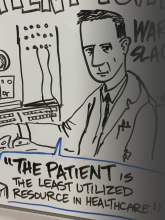Computer-based interview for screening blood donors for risk of HIV transmission.
| Title | Computer-based interview for screening blood donors for risk of HIV transmission. |
| Publication Type | Journal Article |
| Year of Publication | 1992 |
| Authors | Locke SE, Kowaloff HB, Hoff RG, Safran C, Popovsky MA, Cotton DJ, Finkelstein DM, Page PL, SLACK WV |
| Journal | JAMA |
| Volume | 268 |
| Issue | 10 |
| Pagination | 1301-5 |
| Date Published | 1992 Sep 09 |
| ISSN | 0098-7484 |
| Keywords | Adolescent, Adult, Aged, Anonymous Testing, Behavioral Research, Blood Banks, Blood Donors, Diagnosis, Computer-Assisted, Female, HIV Infections, Humans, Interviews as Topic, Male, Massachusetts, Medical History Taking, Middle Aged, Red Cross, Risk Factors, Risk-Taking |
| Abstract | OBJECTIVE: To test the ability of a computer-based interview to detect factors related to the risk of the human immunodeficiency virus (HIV) among potential blood donors and to determine donor reactions to the use of the interview.DESIGN: A comparison of the rate of detection of HIV-related factors elicited by a computer interview with that obtained by standard American Red Cross procedures for assessment of donor suitability, including a randomized crossover trial in which the order of the two methods was reversed. Information obtained by the computer was not available to influence the use of blood components for transfusion.SETTING: The computer interview was administered to donors at an American Red Cross blood donor center and at a mobile blood drive at a hospital.SUBJECTS: Consecutive sample of 294 male and female blood donors 18 to 75 years of age.MAIN OUTCOME MEASURES: Subjects' responses to the computer-based interview as well as responses to the standard Red Cross written questionnaires and face-to-face interviews were used for donor assessment.RESULTS: The interview took an average of 8 minutes to complete. From among 272 donors who provided complete data, the computer identified 12 donors who reported either behaviors associated with a risk of HIV acquisition or symptoms compatible with the acquired immunodeficiency syndrome; none of these donors had been so identified either by routine written questionnaires or by face-to-face interviews used to screen potential blood donors. Only one of the 12 identified donors used the confidential unit exclusion procedure to prevent use of his donated unit. The rate of elicitation of HIV-related factors by the computer interview was 12 (4.4%) of 272 (95% confidence interval [CI], 2.3% to 7.6%), compared with two (0.13%) of 1536 (95% confidence upper bound, 0.28%) using the standard Red Cross procedure (P less than .0001). Tests for antibodies to HIV were negative in blood samples from all of the 272 subjects studied. The subjects enjoyed the computer interview and judged it to be more private than the standard donor assessment method. They also predicted that donors would be more honest with the computer interview than with a human interviewer.CONCLUSIONS: Computer-based screening elicits more HIV-related factors in the health histories of blood donors than do the standard questionnaire and interviewing methods currently in use. Computer-based screening is also acceptable to blood donors. |
| DOI | 10.1001/jama.1992.03490100099034 |
| Alternate Journal | JAMA |
| PubMed ID | 1507376 |
| Grant List | HS06288 / HS / AHRQ HHS / United States |




